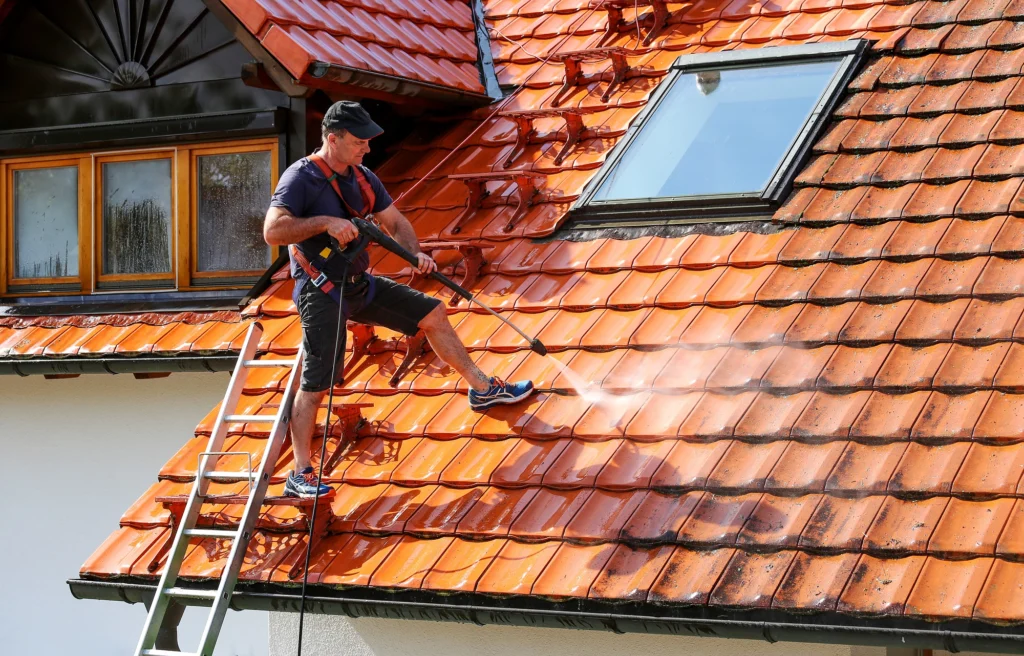The cost of roof cleaning largely depends on the surface area of your roof. Similar to roofing materials such as shingles and underlayment, roof cleaning costs are factored by the size of your roof and the amount of materials and labor involved. On average, a roof cleaning costs between a few hundred to thousands of dollars, but expect to pay about $400 to $450 for the average-sized home.
Roof cleaning helps extend the life of your roof and keeps it in good shape to protect your home. The process begins with an inspection to determine the areas that might need special attention and possible repairs. Then the roof is washed to prevent future surface damage or an accumulation of mold or mildew, which helps to maximize your roof’s lifespan.
Various factors contribute to the overall cost of roof cleaning. The size of your home, the cleaning method used, and your location and environment directly affect your out-of-pocket expenses. Consult with an experienced roofing professional like Ranch Roofing to get a custom quote for your home.
In this article:
- How Much Does Professional Roof Cleaning Cost Near You?
- Factors That Impact the Cost of Roof Cleaning
- Why It’s Important to Clean Your Roof
- How Often Should You Clean Your Roof?
- When Is the Best Time of Year to Clean Your Roof?
- What Does a Roof Cleaning Involve?
- Should You Do It Yourself or Hire Professionals?
- How to Find the Right Roofing Professional
- Is the Cost Worth It?
- Frequently Asked Questions
How Much Does Professional Roof Cleaning Cost Near You?
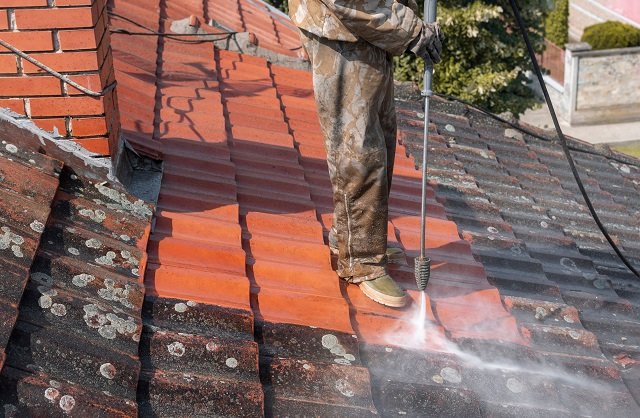
Roof cleaning costs vary from state to state. The average cost in the U.S. is between $250 and $1,050. Your chosen cleaning method impacts the rate, with soft washing as the most common and affordable option.
In higher-cost-of-living states like Massachusetts, Washington, New York, and California, roofing cleaning costs are higher. In lower-cost-of-living states, such as Mississippi, Arkansas, and West Virginia, you can expect to pay a bit less for roof cleaning services.
| State | Average Roof Cleaning Cost |
|---|---|
| Alabama | $250 to $600 |
| Alaska | $300 to $700 |
| Arizona | $300 to $650 |
| Arkansas | $250 to $600 |
| California | $300 to $700 |
| Colorado | $250 to $600 |
| Connecticut | $300 to $700 |
| Delaware | $250 to $600 |
| Florida | $250 to $600 |
| Georgia | $250 to $600 |
| Hawaii | $300 to $700 |
| Idaho | $200 to $550 |
| Illinois | $250 to $650 |
| Indiana | $250 to $600 |
| Iowa | $200 to $550 |
| Kansas | $200 to $550 |
| Kentucky | $250 to $600 |
| Louisiana | $250 to $600 |
| Maine | $300 to $600 |
| Maryland | $300 to $700 |
| Massachusetts | $300 to $700 |
| Michigan | $200 to $550 |
| Minnesota | $200 to $550 |
| Mississippi | $250 to $600 |
| Missouri | $250 to $600 |
| Montana | $200 to $550 |
| Nebraska | $200 to $550 |
| Nevada | $300 to $650 |
| New Hampshire | $250 to $600 |
| New Jersey | $300 to $700 |
| New Mexico | $250 to $600 |
| New York | $300 to $700 |
| North Carolina | $250 to $600 |
| North Dakota | $200 to $550 |
| Ohio | $200 to $550 |
| Oklahoma | $250 to $600 |
| Oregon | $300 to $700 |
| Pennsylvania | $250 to $600 |
| Rhode Island | $300 to $700 |
| South Carolina | $250 to $600 |
| South Dakota | $200 to $550 |
| Tennessee | $250 to $600 |
| Texas | $250 to $600 |
| Utah | $250 to $600 |
| Vermont | $250 to $600 |
| Virginia | $250 to $600 |
| Washington | $300 to $700 |
| West Virginia | $250 to $600 |
| Wisconsin | $200 to $550 |
| Wyoming | $200 to $550 |
*average roof cleaning rates in the U.S.
Roof cleaning is an easy way to maintain your home’s value and curbside appeal. Though there is a base cost for the cleaning method, the pitch of your roof, shape, and complexity also play a part in the bottom line. You also need to consider the location you live in and the typical weather conditions in your area.
For your own safety, it’s best to contact a roofing professional to clean your roof. You’ll get a more accurate estimate when a roofing professional inspects your roof. Plus, an expert can determine if your roof needs repairs as well.
Factors That Impact the Cost of Roof Cleaning
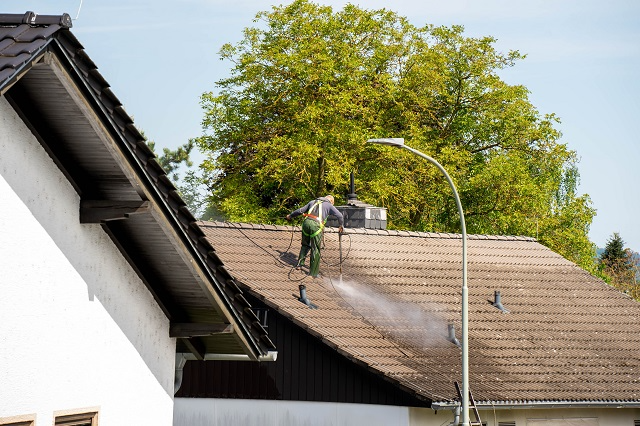
The cost of roof cleaning varies widely due to multiple factors. From the size of your roof to the materials used for cleaning, there’s a range of costs that’s dependent upon details like roof obstacles and access. Consider the following:
- Surface area of your roof: Larger roofs require more materials, labor, and time, naturally making the cost higher.
- Roofing material and condition: The material of your roof — asphalt, metal, or tiles — can change the overall cost of cleaning depending on the cleaning method and solution needed. The current condition of the roof may alter the price because older roofs or those covered in moss may require more than the average cleaning.
- Accessibility and complexity: The complexity of the cleaning work can also impact the cost. If your roof is steep or littered with many obstacles, such as skylights and vents, the risks may increase, and the job may be more difficult to accomplish.
- Location and climate: Your location and climate in your region can affect what it costs to get a roof cleaning in your neighborhood. Environmental concerns such as algae and moss increase the risk of permanent damage and require more frequent cleanings. Sap from overhanging trees can also increase the need for maintenance and repairs.
- Method of cleaning: There are a couple of different methods for cleaning your roof. Soft washing is the most common method for cleaning roof shingles without damage, which uses a low-pressure spray with chemicals to effectively and affordably wash your roof. Pressure washing isn’t recommended unless it’s done by a skilled professional since it can damage your roofing.
- Additional services: Some roofing professionals offer other services like gutter cleaning and roof repair. If you choose to have additional services beyond roof cleaning, then your cost will also increase.
Understanding what roof cleaning means for you and your home can help you find the right roofing professional. It’s important to vet the company you wish to use to ensure it’s licensed and insured properly.
Why It’s Important to Clean Your Roof
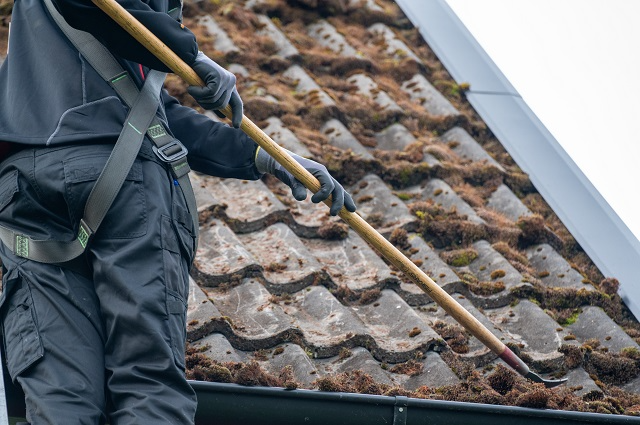
It’s important to clean your roof to maintain the integrity of your home. Cleaning the roof means removing dirt and buildup so your roofing material can perform the job it was designed to do. A roofing professional who cleans your roof can also notify you of and make necessary roof repairs.
Having your roof cleaned regularly is ideal for several reasons, including:
- Damage prevention: Whether your roof is old or newer, roofing materials naturally degrade and become worn over time. Regularly cleaning off dirt and debris helps prevent moisture from getting trapped, which could lead to dry rot, fungal growth, leaks, or structural damage.
- Increased lifespan: Regular cleaning reduces the need for and frequency of repairs, so you’re less likely to need a total roof replacement
- Improved property value: A clean roof improves your home’s curb appeal, helping to maintain or increase property value.
- Energy efficiency: When your roof protects your home the way it was meant to, the insulation helps to keep your home energy efficient. Removing dirt and debris can help your roof properly reflect the heat of the sun to keep your home cool in the summer.
- Pest reduction: Roofs that are covered in dirt or debris may be enticing to all types of pests. Without regularly cleaning your roof, you may find furry, feathery, or winged guests have created nests or tunnels. They may even make their way into your home.
- Working gutters: Often, when your roof is cleaned, so are your gutters. And working gutters help keep water away from home so excess water doesn’t damage your foundation or roof.
- Ice dam prevention: If you live in a climate with long, cold winters, chances are good you’ve had experience with an ice dam. If your roof isn’t cleaned, debris can build up and freeze over during winter, causing a large block where snow and ice are unable to naturally melt off your roof. This could eventually lead to your roof, eaves, or fascia cracking or becoming damaged.
- Homeowners’ insurance: Your homeowners’ insurance may dictate the need for regular cleanings in order to maintain the warranty or insurance coverage.
- Fire prevention: If you live in an area that’s prone to wildfires, regularly cleaning the roof is recommended for fire prevention. Removing flammable debris can help prevent your roof from catching fire due to sparks or flying embers.
Roof cleaning on a regular basis isn’t only about maintaining the curb appeal of your home or property value. It actually helps to preserve your home’s structure, hopefully saving you future repairs and prolonging a potential replacement.
How Often Should You Clean Your Roof?
The ideal roof cleaning frequency depends on multiple factors, but typically, regular maintenance happens once or twice a year. Older roofs may require more regular cleaning and maintenance to help keep your roof in good condition.
Your location can make a difference in how often your roof needs to be cleaned. If you live in an area that features a lot of storms or wind-driven rain, you may need to have your roof cleaned more frequently than an area that sees mostly sunny skies.
If your home is surrounded by trees, especially those with excess sap or falling leaves, you probably want to have your roof cleaned at least a couple of times per year, maybe more. Likewise, excess humidity and moisture may call for cleaning vegetation off your roof a few times a year.
The ideal cleaning schedule also varies between different types of roofing materials. Asphalt shingles benefit from cleaning once or twice a year, and they often last longer if this schedule is followed. Metal roofs require cleaning at least once a year, although tile or slate roofs may only need cleaning every other year or so. Check with your roofing professional or the manufacturer of your roofing materials for specific requirements for your roof.
When Is the Best Time of Year to Clean Your Roof?
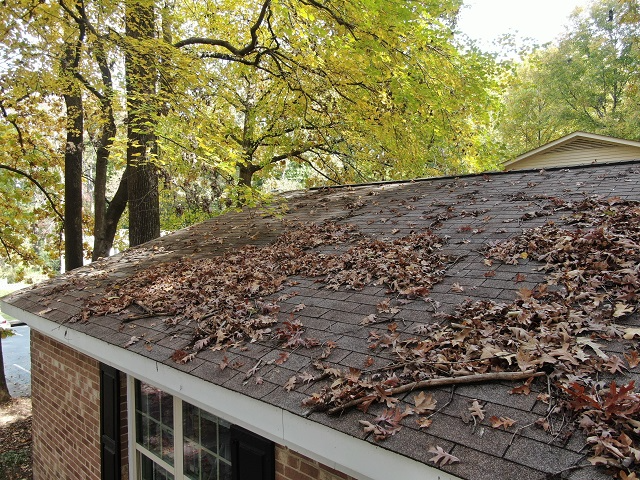
For the majority of homeowners, roof cleaning is best done in the fall. This time of year gives roofers better weather to complete the job — not too hot, not too cold — while allowing you the opportunity to get your roof cleaned before winter hits, helping to prevent ice dams.
Homes surrounded by trees should be cleaned twice a year, typically in the spring and fall. Fall cleaning prepares your home for winter, while spring cleaning gets rid of whatever issues arose during a harsh winter and gets it ready for summer.
Cleaning your roof before and after winter helps prevent damage from excess moisture or hibernating pests. It also prevents the growth of fungus and helps to maintain your home’s energy efficiency. However, inclement weather like heavy rain or snow may mean that you need to clean your roof at least a few times each year.
What Does a Roof Cleaning Involve?
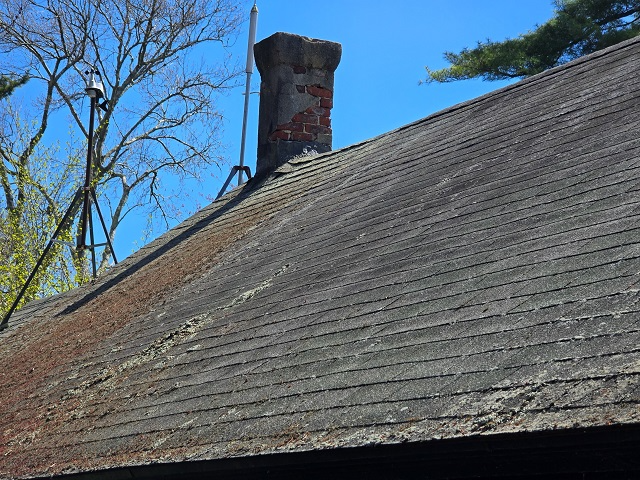
A roof cleaning involves a few steps that may vary depending on the type of roof you have, its size, and the cleaning method chosen. Consider the following steps:
1. Inspection
The first step that needs to happen is an inspection. A professional roofer will inspect your roof to determine its overall condition and identify specific areas of concern. They’ll look for signs of fungus growth, rot, and excess debris or moisture.
2. Preparation
Preparing your roof for cleaning involves taking certain safety measures. Professional roofers will use safety equipment and roofing ladders to ensure the job is done correctly. Homeowners should cover and protect bushes, plants, and patio furniture from falling debris or any cleaning solution runoff.
3. Removal of Debris
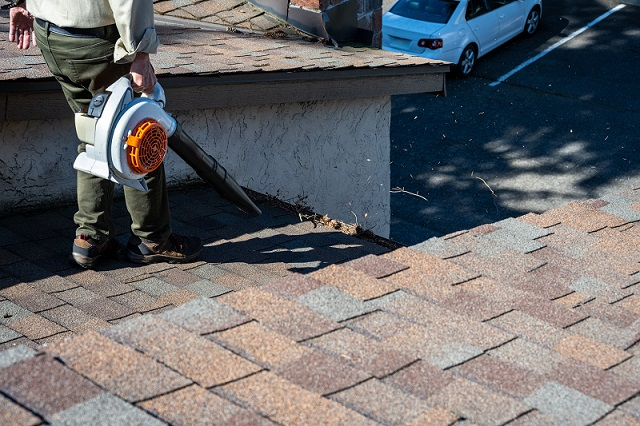
After inspection and preparation, your roof is swept clean of loose debris and dirt. The roof cleaner may use a roof rake, broom, or leaf blower to remove things like branches, leaves, needles, and twigs. This step helps expose the roofing material so it can be cleaned or repaired properly.
4. Cleaning the Roof
Soft washing is the most commonly used roof cleaning method. This method uses a low pressure water sprayer that’s more gentle on a roof than high-pressure washing. It also requires a cleaning solution that’s usually made from biodegradable detergents.
After the roof is sprayed with the cleaning solution, it typically sits for a period of time so the cleaning agents can break down excess dirt and moss. Then the roof is rinsed with regular water to wash it all off the roof.
5. Cleaning the Gutters
The falling debris and dirt from a roof cleaning will more than likely end up in your gutters. Check with your roofing professional, but there’s a good chance your gutters will get cleaned out after your roof is taken care of.
6.Final Inspection
Once your roof has been cleaned, it should be inspected once again to ensure everything that needed to be addressed was taken care of. It’s easier to discover issues requiring repair when the roof is not cluttered with debris.
Should You Do It Yourself or Hire Professionals?
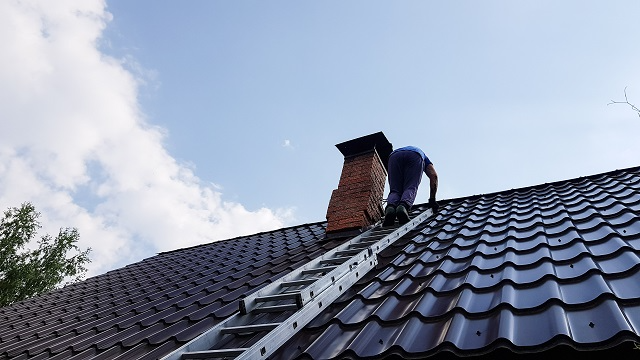
Unless you’re an expert yourself, cleaning your roof is best left to the professionals. While there are pros to doing it yourself, your safety outweighs them. Falling off your roof is a significant risk.
Reasons to hire a roofing professional include:
- Safety: Roof cleaning involves climbing to tall heights, increasing your risk of a severe fall. Roofing professionals have proper safety equipment and training to stay safe on a roof.
- Know-how: Understanding the roofing industry and different types of roofing means the workers can do the job correctly, minimizing the possibility of damage. A skilled eye can also tell when there’s a minor leak or repairs are needed.
- Efficiency: Since roofing professionals are ready for this type of job, they can get it done quickly and efficiently, ultimately saving you time. Experts are also trained to clean roofs on large houses or those with steep pitches.
- Liability: A qualified roofing professional will be insured, possibly bonded, and appropriately licensed to work on your roof. There may also be a stipulation in your original roof warranty that requires professional roofers to clean your roof.
Though cleaning the roof yourself may seem tempting, it’s wise to consult with a qualified roofer to determine your best course of action.
How to Find the Right Roofing Professional
Finding the right roofing professional for cleaning your roof involves asking yourself a few questions. Consider the following:
- What type of roof cleaning do you need? Determine what type of cleaning your roof may need. Know the size of your roof and the roofing materials used. Make note of any problem areas you’re aware of.
- What have past customers said about the roofing professional? Ask your neighbors for recommendations. Read past reviews and testimonials to learn what homeowners in your neighborhood are saying. Check with professional roofing organizations about the roofing company you’re considering.
- What type of qualifications does the company have? Look into the qualifications a roofing professional should have, such as licensing, insurance, or bonding. Some requirements may vary depending on your location. Liability insurance protects you, the homeowner, in case of issues or accidents. Check to see if a certification is needed for the particular cleaning method you’re opting for.
- Is it a professional company that’s been in business for a while? What’s the expertise of the roofing company? Have they communicated clearly with you what cleaning entails? Go with a roofing professional who offers an inspection before performing any work to make sure your specific roofing needs are addressed. Some roofing professionals offer free inspections and estimates.
- Do they offer other services? Many qualified roofing professionals offer a range of services. If you need multiple things done, check with the company to see what else they offer and if they have packages available.
Is the Cost Worth It?
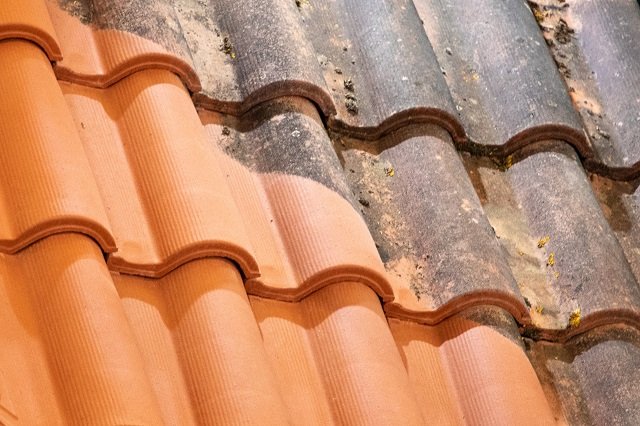
The amount of money, time, and energy you spend taking care of your roof is worth the investment. There are many benefits to cleaning your roof and doing overall maintenance. Advantages include:
- Preventing a buildup of dirt and debris
- Cleaning moss from your roof as well as mildew, or mold
- Reflecting sunlight better
- Extending the roof’s lifespan
- Maintaining or increasing your home’s property value
- Improving energy efficiency
- Reducing the need for repairs
- Aesthetic appeal
Some factors to consider when thinking about the cost include the upfront, out-of-pocket cost, potential future expenses, safety measures, and additional maintenance.
If you think your roof is in need of cleaning or you’re unsure what your roof’s maintenance requirements are, contact Ranch Roofing today. Our experienced roofing professionals will provide you with a free inspection and estimate for any services, repairs, or replacement needed.
Frequently Asked Questions
How to calculate roof cleaning?
Calculating roof cleaning involves the surface area of your roof, the type of materials used, and the labor needed to complete the task. Since these factors can vary, a roof cleaning ranges in price from hundreds to thousands of dollars.
Is soft washing a roof worth it?
Soft washing is a low-pressure cleaning method that uses a special solution to gently clean your roof. It’s the most common way to clean a roof. It’s worth it for homeowners who are looking to maintain the roof’s integrity, enhance their home’s appearance, and reduce future repair costs.
Can I clean my roof myself?
It’s better to hire a professional roofer to clean your roof. Climbing up on your roof comes with a significant safety risk. Additionally, using the wrong cleaning methods or solutions could damage your roof, so it’s worth having a skilled technician perform the work.
What are the cons of roof cleaning?
The cons of roof cleaning include:
- Potential for damage
- Upfront cost
- Runoff from cleaning solution
- Safety risks
- Frequency of cleaning
What are the advantages of roof cleaning?
Roof cleaning offers several advantages, including:
- Improved aesthetics
- Prevents algae and moss growth
- Extends roof lifespan
- Increased energy efficiency
- Prevents structural damage
- Lowers overall maintenance costs
- Reduces the risk of ice dams
- Early identification of needed repairs
What is the best roof cleaning method?
The best roof cleaning method depends on the type of roofing material your house is outfitted with and the specific issues your roof may have. The different methods include:
- Soft washing: A low-pressure spray that uses a biodegradable cleaning solution, which is recommended for asphalt shingles and metal roofing. This method is gentle on roofs and is ideal for removing fungal growth, but it takes time to penetrate your roof to adequately clean it.
- Pressure washing: A high-pressure spray that uses water to remove dirt and debris. This method is very effective but can potentially damage roofs if not used correctly.
- Manual cleaning: Manual cleaning refers to hand-scrubbing a roof with brushes. This method is for roofs that are particularly delicate, such as tile roofing.
- Dry ice blasting: A high-pressure method that uses dry ice pellets to blast away dirt and debris. This method is effective without chemicals but is not meant for residential use.
- Steam cleaning: High-temperature steam cleans some roofing materials, effectively killing mold and other vegetative growth. There is a risk of damage, however.

